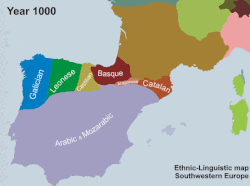Aragonese language
The Aragonese language is a Romance language spoken in the north of Aragon by 10,000 people.
| Aragonese | ||||
|---|---|---|---|---|
| aragonés | ||||
| Pronunciation | Aragonese pronunciation: [aɾaɣoˈnes] | |||
| Native to | Spain | |||
| Region | Aragon; northern and central Huesca and northern Zaragoza | |||
| Ethnicity | Aragonese people | |||
| Native speakers | 25,500 (2011)[1] including speakers living outside the native area (2011) | |||
| Language family | Indo-European
| |||
| Early forms: | Navarro-Aragonese
| |||
| Writing system | Latin (Aragonese alphabet) | |||
| Official status | ||||
| Regulated by | Academia Aragonesa d'a Luenga | |||
| Language codes | ||||
| ISO 639-1 | an | |||
| ISO 639-2 | arg | |||
| ISO 639-3 | arg | |||
| Linguasphere | 51-AAA-d | |||
 Map of Aragon with the dialects of northern Aragon in gray, blue, and light orange | ||||
| ||||
It is similar to nearby languages: Spanish, Catalan and Occitan. Also, many Aragonese words are similar to Basque words.
History
Aragonese, which developed in parts of the Ebro basin, can be traced back to the High Middle Ages. It spread throughout the Pyrenees to areas where languages almost the same as modern Basque might have been spoken before. The Kingdom of Aragon (formed by the counties of Aragon, Sobrarbe and Ribagorza) expanded to the south from the mountains. It pushed the Moors farther south in the Reconquista and spreading the Aragonese language.
The union of the Catalan counties and the Kingdom of Aragon which formed the 12th-century Crown of Aragon did not merge the languages of the two areas; Catalan continued to be spoken in the east and Navarro-Aragonese in the west. The Aragonese Reconquista in the south ended when James I of Aragon gave Murcia to the Kingdom of Castile as dowry for an Aragonese princess.
The best-known writer in Aragonese was Johan Ferrandez d'Heredia, the Grand Master of the Knights Hospitaller in Rhodes at the end of the 14th century. He wrote a lot of works in Aragonese and translated several works from Greek into Aragonese (the first in medieval Europe).
The spread of Spanish, the Castilian origin of the Trastámara dynasty, and the similarity between Spanish and Aragonese helped the decline of the latter. A turning point was the 15th-century coronation of the Castilian Ferdinand I of Aragon, also known as Ferdinand of Antequera.
In the early 18th century, after the defeat of the allies of Aragon in the War of the Spanish Succession, Philip V ordered the prohibition of the Aragonese language in the schools and the institution of Spanish as the only official language in Aragon. This was ordered in the Aragonese Nueva Planta decrees of 1707.
In recent times, Aragonese was mostly seen as a group of rural dialects of Spanish. After the 1978 Spanish transition to democracy new books and studies of the language have been published.
Aragonese Language Media
Map of the Occitano-Romance languages: Catalan in red, Occitan in purple and Aragonese in yellow.
References
| This language has its own Wikipedia project. See the Aragonese language edition. |



